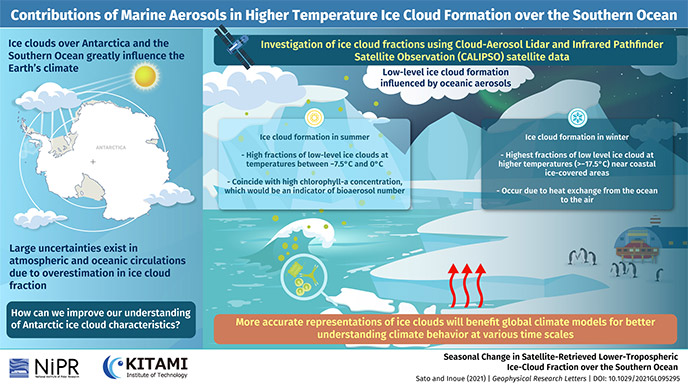National Institute of Polar Research
A Song of Ice and Cloud: Marine Aerosols from Southern Ocean Help Summer Ice Cloud Growth
Scientists uncover key contributor to Antarctic ice cloud cover; findings to aid improved accuracy of climate models
Posted on December 10, 2021
Simulating the behavior of polar cloud cover in climate models is complex. Aerosols act as “ice-nucleating” particles that guide the cloud formation process. Understanding the contributions of aerosols to ice cloud formation would help improve the accuracy of climate models. A recent study explains how marine aerosols contribute to ice cloud formation over the Southern Ocean at comparatively high temperature conditions.
Climate models are digital simulations of the Earth’s climate system. These models calculate the interactions of various drivers of climate, such as land, sea, atmosphere, and humidity among others and forecast the future climate of the world. Yet, simulating clouds, a key factor of the Earth’s climate system, has always been challenging. Their complex behavior makes it easy for climate modelers to misestimate cloud cover.
Recently, a duo of climate scientists from Japan—Assistant Professor Kazutoshi Sato from Kitami Institute of Technology and Associate Professor Jun Inoue from the National Institute of Polar Research—answered a few critical questions on cloud formation over Antarctica and the Southern Ocean. “Ice clouds are normally formed under very cold conditions (under -38 °C), but we observed the formation of low-level (under 6500 feet) ice-clouds at significantly higher temperatures,” says Dr. Sato. Their research, published in the journal Geophysical Research Letters, was published on 9 December 2021.
“Aerosols” —tiny particles suspended in the air upon which water vapor condenses at high altitudes —are a crucial factor to cloud formation. Breaking waves and squally winds disperse aerosols from the sea into the atmosphere. These particles then become the starting particles for a type of cloud called “ice clouds” and are hence called “ice-nucleating particles” (INPs). As the ice cover on the polar sea surface changes with temperature, the concentration and activity of INPs changes too, thereby influencing cloud formation. “There are large uncertainties in current numerical climate models because of overestimation in ice-cloud fractions, especially in atmospheric and oceanic circulation. Understanding the sources of INPs will go a long way towards mitigating this issue,” explains Dr. Inoue.
Documenting cloud characteristics in remote polar regions is challenging from the ground. To overcome the issue, the scientists used data captured by the Cloud-Aerosol Lidar and Infrared Pathfinder Satellite Observation (CALIPSO) satellite. Based on these data, they estimated the seasonal variation in the ice cloud fraction over Antarctica and the Southern Ocean. They also investigated the relationship between low-level ice clouds and sea surface conditions in summer and winter.
Marine phytoplankton blooms are considered a source of bioaerosols. The scientists also used the satellite data to measure the concentration of chlorophyll on the sea surface to provider an indicator of phytoplankton abundance in the upper layers of the ocean. Finally, they reanalyzed the existing data to understand precisely the extent of gas and particle exchange between the ocean and atmosphere.
They found that there was a sizeable difference in ice cloud formation at the low- and mid-levels (6500–20,000 feet) between summertime and winter. High fractions of low-level ice clouds were observed at comparatively high temperatures (above −7.5°C) over coastal Antarctic Sea ice areas in the summer. This increased ice cloud cover coincided with the highest estimated populations of phytoplankton. In winter, low-level ice clouds were observed at temperatures above −17.5°C, a time during which substantial heat exchange took place from the ocean to the air near coastal areas. Dr. Sato emphasizes, “Our findings suggest that marine aerosols emitted from the ocean contribute to low-level ice-cloud formation over the Southern Ocean even under higher temperatures.”

Contributions of marine aerosols in higher temperature ice cloud formation over the Southern Ocean. Credit:Kitami Institute of Technology and National Institute of Polar Research
Ongoing climate change is causing rapid environmental changes; changes that are being felt acutely in the polar regions. Dr. Inoue highlights the importance of their findings, “Developing reliable global climate models are essential to improving our understanding and predictions of climate behavior. By clarifying the relationship between ice clouds and marine aerosols, our study will help reduce the errors associated with cloud biases in a numerical climate model.”
Improving the accuracy of climate models is the defining challenge of our time, but with findings like this to help us on our way, we are sure to succeed.
Original article:
Journal: Geophysical Research Letters
Title: Seasonal Change in Satellite-Retrieved Lower-Tropospheric Ice-Cloud Fraction over the Southern Ocean
Authors:
Kazutoshi Sato (Kitami Institute of Technology)
Jun Inoue (National Institute of Polar Research)
DOI: 10.1029/2021GL095295
URL: https://agupubs.onlinelibrary.wiley.com/doi/10.1029/2021GL095295
Published Online: 9 December, 2021
Funding:
The Japan Society for the Promotion of Science (JSPS) JP20H04963, JP19K14802, JP18H05053








